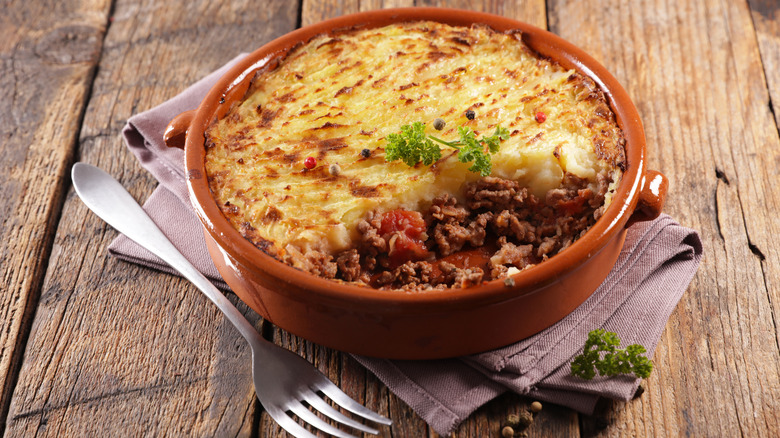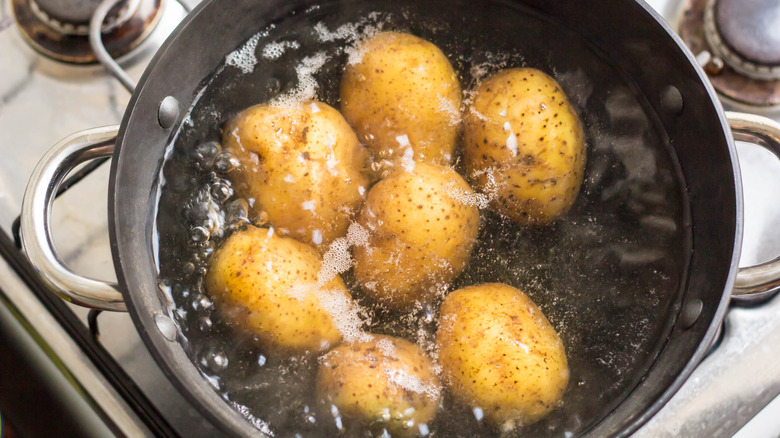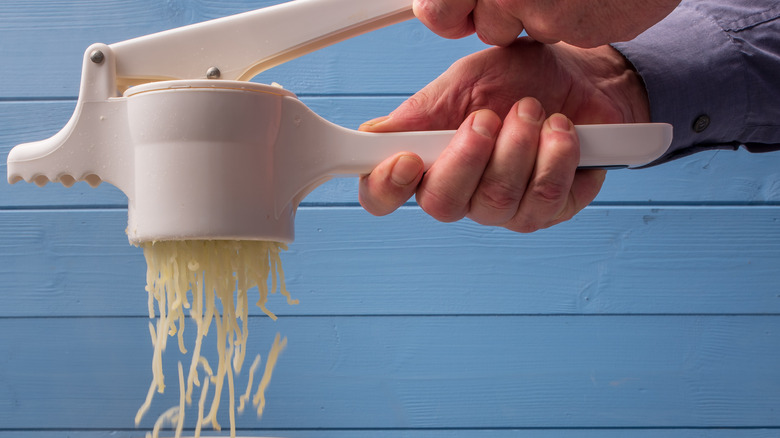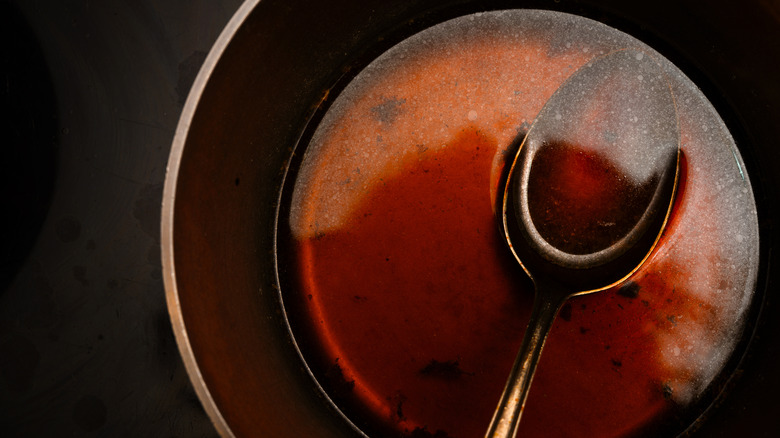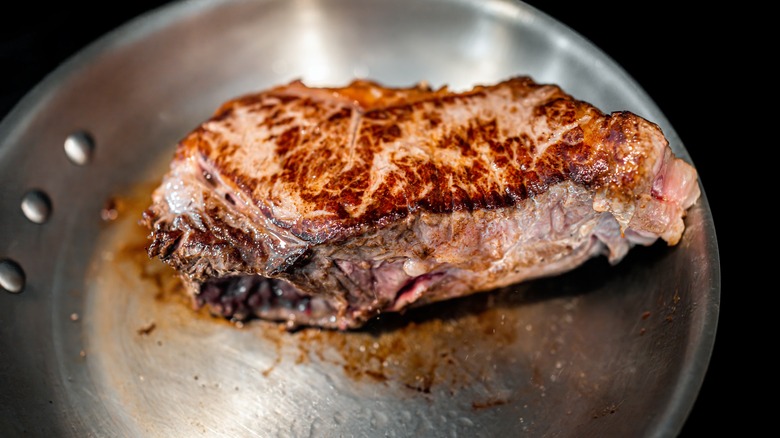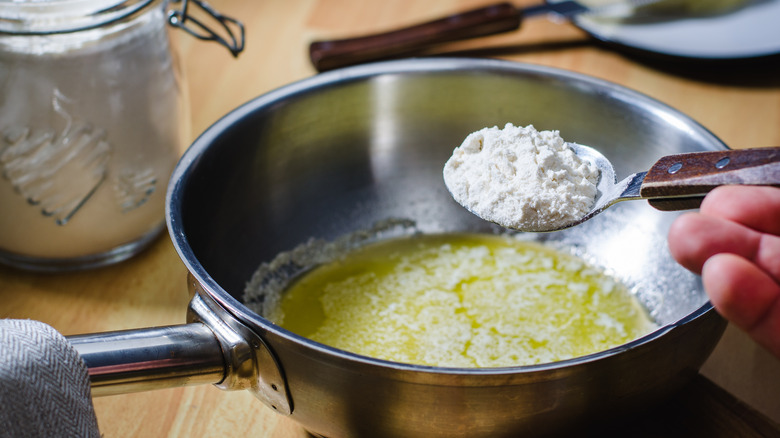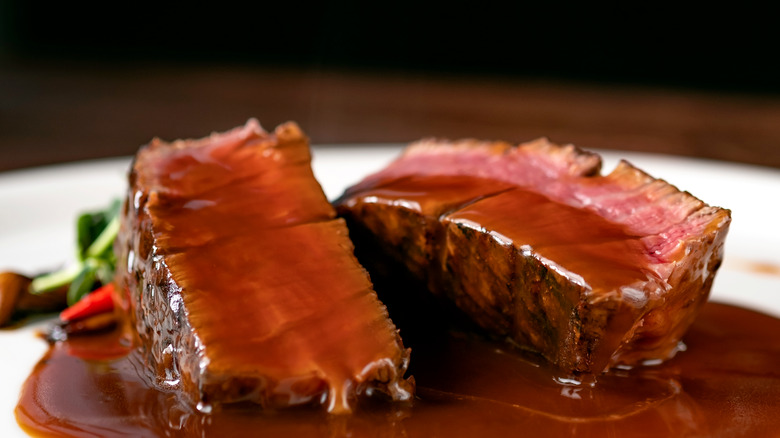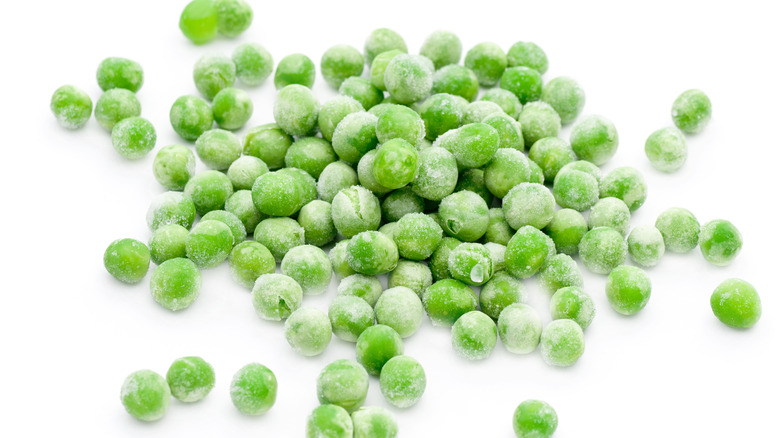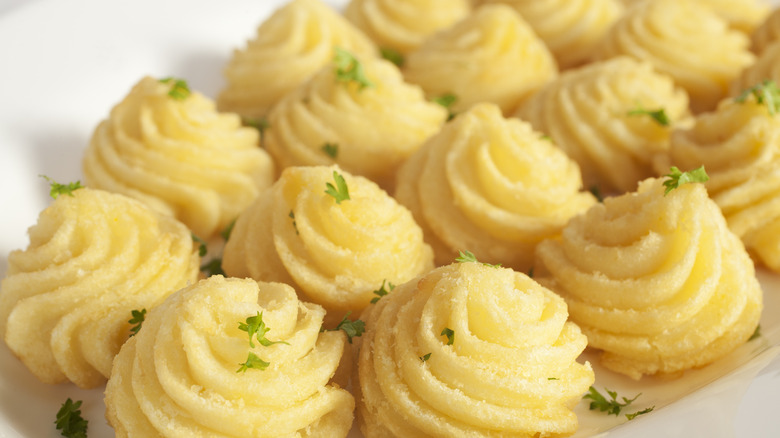8 Shepherd's Pie Mistakes You Might Be Making
We may receive a commission on purchases made from links.
Shepherd's pie is a classic Irish dish that's become a staple in many family households — it's a time-honored favorite. The first iterations of this dish, during the late 18th century, were born from a need to make do with leftover kitchen scraps. Home cooks took their remaining pantry vegetables and leftover cuts of meat and transformed these ingredients into a crowd-pleasing meal. From its rich gravy-like filling to the creamy yet crispy mashed potato topping, it's nearly impossible to not enjoy eating.
How each component of shepherd's pie is crafted (within the process of cooking) is important, even down to the type of meat chosen. For example, a variation of shepherd's pie is cottage pie which uses ground beef and beef stock to bring a hearty texture and taste — while the traditional recipe calls for ground lamb which brings a gamey, complex flavor. Whether it's cottage or shepherd's pie, the underlying beauty of this dish is its versatility and how easy it is to highlight different flavors within its ingredients.
What might be challenging, however, are perfecting the steps leading up to the finished product — because while this dish seems fairly simple, its execution can be layered to get right. To ensure these elements shine in the best way — and you avoid making certain mistakes — keep these tips in mind to get the absolute best results.
Start your potatoes in cold water
Versatility is a wonderful quality of shepherd's pie, as you can customize each part of the dish to your preferences. Take the potato topping, for instance, a delicious element that is the first thing you see when the dish comes out of the oven. Some variations of shepherd's place higher importance of the potato element more than others, such as the French Hachis Parmentier which features two layers of potatoes and a layer of meat between them, according to MasterClass. Whichever recipe you prefer, it's important to get the potatoes cooked correctly to have consistent texture, and to spread evenly — and, of course, for the best taste.
To get potatoes evenly cooked, soak the potatoes of choice in cold water once you've cut or diced them. Too much starch is the usual culprit that can ruin the texture of your mashed potatoes, which if left inside the potatoes while they cook will create a gummy texture on the outside (via Potatoes USA). Letting the potatoes sit in cold water first will help let the excess starch leach out from the potatoes before you boil.
And the use of cold water doesn't stop there; you should also use a pot of cold water on the stove to start with your cut potatoes. As food columnist Gholam Rahman of the Palm Beach Post notes, this helps ensure that the potatoes are cooked evenly. Rahman says, "Sudden immersion in boiling water would tend to overcook the outer part before the inside gets tender."
Use a ricer to get the best potato consistency
So you've cooked your potatoes successfully, congrats! Now comes the difficult part of getting the right level of mashed into the potatoes. With some types of potatoes this task isn't too difficult, as a softer choice (sweet potato comes to mind) is very moldable and naturally creamier when pressed. Other potato options that are better for mashing, such as Yukon Gold potatoes, according to Bon Appétit, need some extra handling. Enter the ideal tool to get perfect mashed potatoes: The potato ricer.
As noted, excess starch can cause potatoes to become gummy or stodgy when mashed. If using a hand mixer and potato masher, these tools would work the potatoes too much and release more starch in the process, making it harder to achieve a thick, creamy texture.
A potato ricer's design is crafted to lessen the energy it takes to mash the potatoes to the right texture, keeping them firm yet fluffy. The ricer will also ensure that this texture is consistent without lumps, which also helps with adding extra flavor ingredients for the shepherd's pie, such as butter, cheese or seasoning. If this gadget seems like a non-essential, ricers have more uses than just making mashed potatoes — from mashing other ingredients to get sides like hummus and riced cauliflower to squeezing juice out of pomegranate seeds.
If adding alcohol, choose wisely based on flavor preference
The depth of flavor that exists within a shepherd's pie comes primarily from the meat and vegetable mixture that sits in a rich, gravy-like sauce. However, so much flavor can come from the base ingredients alone. What truly transforms the taste profiles are specific additions, one of which includes a choice of alcohol used to reduce the cooking liquid. Depending on what peaks of the palate you want to reach with this dish, there are certain choices that can achieve different levels of interest.
Adding alcohol to the gravy of shepherd's isn't necessarily traditional, according to many Reddit users, who note that plenty of flavor derives from the meat. However, acclaimed chefs like Gordon Ramsay have notably taken this customizable recipe and added their own flair by reducing wine or beer with chicken or beef stock. A wine reduction is typically a great way to infuse a subtle, yet powerful boost of flavor, especially to meat when cooked slowly. Beer or ale can also be used to cook down into the sauce, to enhance the liquid with a deeper meat flavor that can be balanced with fresh or dried herbs and hearty vegetables.
If more complex flavors interest you, a dry red wine is best used in the reduction. A Spanish Red rioja variety can be paired to drink with the shepherd's pie, as the savory flavors will complement the lamb, according to award-winning food and wine writer Fiona Beckett. Regarding beer, shepherd's pie is an iconic Irish dish, so hitting the sauce with a hefty splash of Guinness, or any dark stout, should give the flavor an edge.
Develop fond in the pan for great meat flavor
The term fond simply refers to the caramelized bits of cooked food that coat the bottom of a pan that build up over time, most commonly with meat. This layer, as it builds, is essentially a coating of pure flavor that if tempered properly can be utilized to enhance your dishes. To fully benefit from the fond, there are some key details to keep in mind and tips to get it exactly right.
The first step is to ensure you use the correct pan, as you need to achieve a high heat to get the right sear on meat that promotes caramelization. A nonstick pan is ill advised, as a fond can't develop on the surface. Top choices would instead be a stainless steel or cast iron pan where the heat can be high and fond can build. For a dish like a shepherd's pie, you could even utilize a larger vessel such as a Dutch oven to allow more space for fond to develop. Even more important to keep in mind, however, is the liquid in order to deglaze the pan.
Chicken or beef stock and any added alcohols are the ideal deglazing liquids to use in a shepherd's pie, as these will reduce into a thicker, richer gravy. Scraping the bottom of the pan after you've added the liquid helps release the fond and harnesses the flavor developed within the fond. The best tool for this job is a flat-edge spoon to get every area of the pan. You can also use this tool to check the consistency of the sauce, according to the Detroit Free Press, which should coat the back of the spoon without running off easily.
Cook off the flour to ensure a thick gravy
There are many ways to make gravy, according to Chef Tariq, whether from the help of thickening agents like flour, cornstarch and arrowroot, or simply adding pureed vegetables. Because the gravy-like sauce is essential to the composition of a shepherd's pie, it's important to get its consistency perfect. To ensure this, using a thickener like flour is advised, though tricky to get exactly right. Whichever way you incorporate the flour, it's important to cook the mixture long enough to get the ideal taste and consistency.
Cooking the flour as a slurry or in a roux activates the liquid and fat with the flour, which eventually develops into a thicker sauce. You will know if you did not cook it long enough if the sauce tastes like flour, a result that can ultimately still be fixed. A few additional minutes of cooking at a higher temperature, with more deglazing liquid such as stock, wine, or beer, will help rid the flour taste. This, however, will mean you will need to cook the mixture longer to account for the extra liquid.
Include demi-glace when adding your liquids
The simplicity of a shepherd's pie is what makes it a seemingly easy meal to achieve. However, there are ways of elevating this dish to an exquisite dinner with a professional chef-level secret ingredient — demi-glace.
We've already noted the wonders a reduction of wine or beer can add to the flavors within a shepherd pie's meat layer. Demi-glace is essentially a reduction of broth, made from roasted meat bones and vegetables, into a thick, almost syrup-like consistency. This sauce can be used on its own because of the amount of flavor it delivers, such as a Chicken Balsamic, though it adds a unique taste when incorporated into dishes as well. A small amount in your shepherd's pie could be the custom element that transforms your recipe into a one-of-a-kind masterpiece.
Though it can be a time-consuming, somewhat arduous process, there is no substitute for making demi-glace from scratch. According to food columnist Claire Perez of the South-Florida Sun Sentinel, the task is incredibly rewarding if done the right way, preferably starting with the stock. "Veal bones are preferred over beef bones due to their high collagen content," she says, noting the high levels of collagen create a thicker, richer stock.
Choose frozen over fresh peas
Peas are an iconic ingredient incorporated into a typical shepherd's pie recipe, sometimes as its own layer between the meat and potatoes. If utilizing peas in your own recipe, the question of choosing between fresh versus frozen peas might seem difficult to answer confidently. However, the choice is clear: Frozen peas will result in better texture and taste.
Peas are somewhat fickle when used fresh, according to Times of India, and can begin to go stale if not used quickly enough after picking. Not to mention the process of shelling the peas from the pods can be a time-consuming task. The frozen option not only removes this middle step, but ensures a higher level of nutrients added to your meal. Frozen peas are flash frozen at peak ripeness, preserving their sweet taste and unique texture. If being used in shepherd's pie, adding peas is as easy as opening the bag, as one home chef claims that "the peas seem to cook just fine in the time [the pie] takes to brown in the oven," (via Mumsnet).
Pipe your potatoes for the top layer
Probably one of the most superficial tips to getting the ideal shepherd's pie is based on aesthetic, namely how the potato layer on top looks. The easiest way of getting the potatoes situated on top of a casserole-sized dish is spooning them on. However, this method does not allow for the best results. Some areas could have more potato topping than others, no matter how much you level off. Plus, simply spooning the potatoes on top could result in spilling gravy initially, or leaving areas for the sauce to bubble out of during time in the oven.
A better way of topping your shepherd's pie with potato is piping the mashed mixture into an even layer on top of the meat filling. This does require getting the mashed potatoes into a smooth consistency in order to fit through the tip of the piping bag. Some would even advise incorporating an egg to the mashed potato mixture, to keep a thick, creamy texture when baking.
Pastry bags are the most useful of the professional equipment, but you can also achieve this with a gallon-sized ziplock bag with the tip snipped off. After piping the mixture you can then smooth it out to create a uniform presentation, then rough up with the tips of a fork or edge of a metal spoon. This craggy exterior will create different ripples of texture to catch levels of crispiness in the oven. And, of course, it'll look beautiful!
